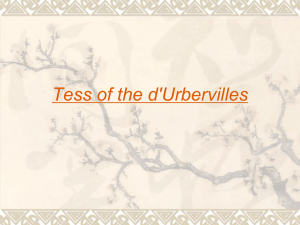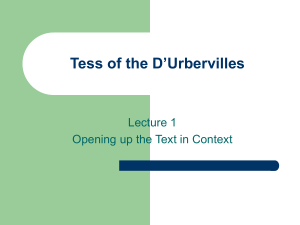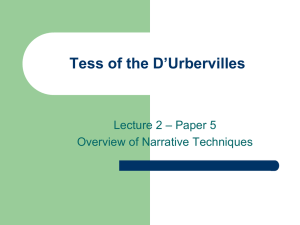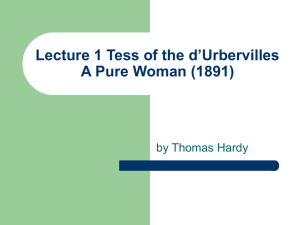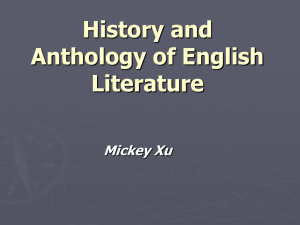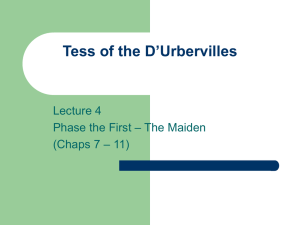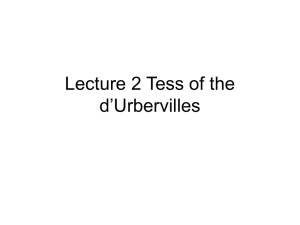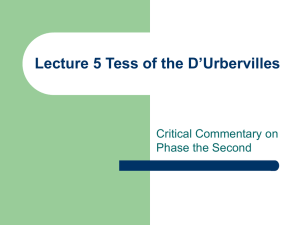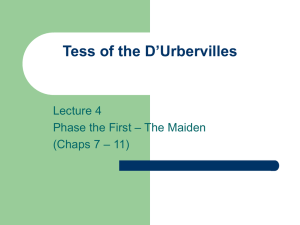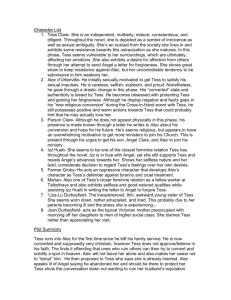Tess of the d`Urbervilles ppt
advertisement
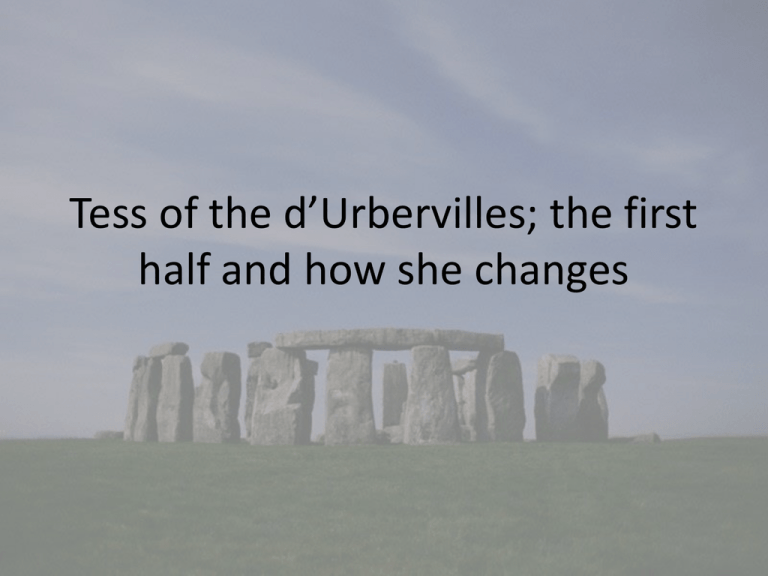
Tess of the d’Urbervilles; the first half and how she changes The Young Tess, chapters 1-4 • We are first introduced to Tess as a girl of about 16, participating in a country dancing tradition. This happens on May Day, significant due to the connotations it holds of fertility and future prosperity; this is also suggested through Hardy’s description of the ‘fertile and sheltered tract of country’ and secluded yet beautiful landscape. • Tess herself is portrayed as pure, white and innocent – a metaphor by Hardy for virginal. This description is carried on throughout the novel, before Alec’s seduction and whilst she is with Angel. She is described as ‘a fine and handsome girl...her large innocent eyes added eloquence to colour and shape...’ • Despite the fact that ‘Tess at this time in her life was a mere vessel of emotion untinctured by experience’, we are still given a sense of her pride, which even from such a young age is recognised as one of her negative traits. • Her dialect and speech reminds us that she is still a young girl who has no knowledge of what lies beyond Marlott Tess at Trantridge with Alec d’Urberville, chapters 5 & 6 • • • • • • In these chapters, we see Tess’ innocence slowly ruptured by Alec d’Urberville’s persistence. It is not so obvious how he exploits her in this chapter as in ‘The Chase’ scene, but it is clear he is acting and talking in a way which manipulates her and makes her feel inferior, a feeling already present due to his obvious status over her both as a male and an ‘aristocrat’ . The ripe fruit and blossoming flowers not only contribute to the image of her as innocent and pure, but allow us to imagine the fertility which lies in both Alec and Tess – foreshadowing what is to come in chapter 9. ‘...there behind the blue narcotic haze was potentially the ‘tragic mischief of her drama – one who stood fair to be the blood-red ray in the spectrum of her young life’ The colours present in this passage are implicit of the misendeavor yet to come: the blue of Alec’s smoke suggest an atmosphere of uncertainty or haziness, which translates later on into the Chase scene in which everything is covered in fog and therefore makes it difficult to account for the actions of both Alec and Tess. The blood-red of Tess’ life is suggested here to be given to her by Alec. The deaths of Prince, Sorrow and Alec himself are either to do with the d’Urberville or lead Tess to Alec, so it is fitting he is associated with this colour. There are many descriptions through the book of her white dress becoming stained – he is the stain upon her pure life. ‘she had an attribute which amounted to a disadvantage just now...which made her appear more of a woman than she really was.’ Allows Alec to exercise even more control over her , but puts her in more danger. She is seen as more of an equal but along with it comes the responsibilities and circumstances. Tess and Alec in The Chase, chapter 11 • • • • • The censorship of the ‘rape’ of Tess means this part of the novel is left very ambiguous; we do not know how forcefully Alec behaves towards Tess, or to what extent she consents to his advances. However, this part of the novel is hugely significant for many reason. Firstly, it is the underlying reason for Tess’ eventual downfall, contributing to a series of events which end in catastrophe. The consequence of The Chase scene is the baby, which Tess names Sorrow and who dies of sickness. It is the sole reason for Angel’s desertion of her later in the novel, and perhaps most significantly it marks a real change in Tess’ personality. She believes that she is destined to have a blighted life, resulting in her conviction that her unhappiness is inevitable and a feat which changes when she meets Angel. ‘...upon this beautiful feminine tissue...there should have been traced such a coarse pattern as it was doomed to receive.’ The ideas Hardy has of fate and foreshadowing are made clear in this scene, as well as his scepticism of God when he questions ‘where was Tess’ guardian angel?’ It seems to confirm Tess’ bad luck and her transition from an innocent girl who knows not of the dangers of the world to a woman who must accept what has happened to her. Tess meets Angel, chapters 18+ • • • • • • • Angel epitomises everything Tess has been yearning for; he is considerate, gentle, loving, handsome and eloquent. His appearance at the dairy allows her a kind of escapism; she tries to resist his temptations, and in this we see a glimpse of the old Tess (she feels she is not worthy of him). Her attempted distancing from him demonstrates her acknowledgment of her past actions, indicating she has learnt form her past mistakes and is not inclined to burden someone else with her past trials. Angel accepts Tess for who she is and falls in love with her. Tess knows the dangers of men, yet cannot help herself from becoming attached to him: ‘Tess had never in her recent life been so happy as she was now, possibly never would be so happy again’ They idealise each other: ‘What a fresh and virginal daughter of Nature that milkmaid is!’ ‘Tess seemed to regard Angel Clare as an intelligence rather than as a man’ There are continuous religious references throughout, indicating the eventual downfall of the two lovers but also highlighting the blissful state in which they are living. Tess has allowed her inhibitions to leave her; arguably this is unwise, but the conscience inside her knows that it is imperative for Angel to realise what has happened in her past.


